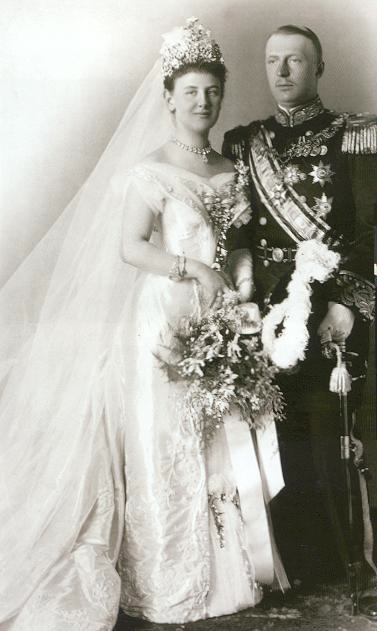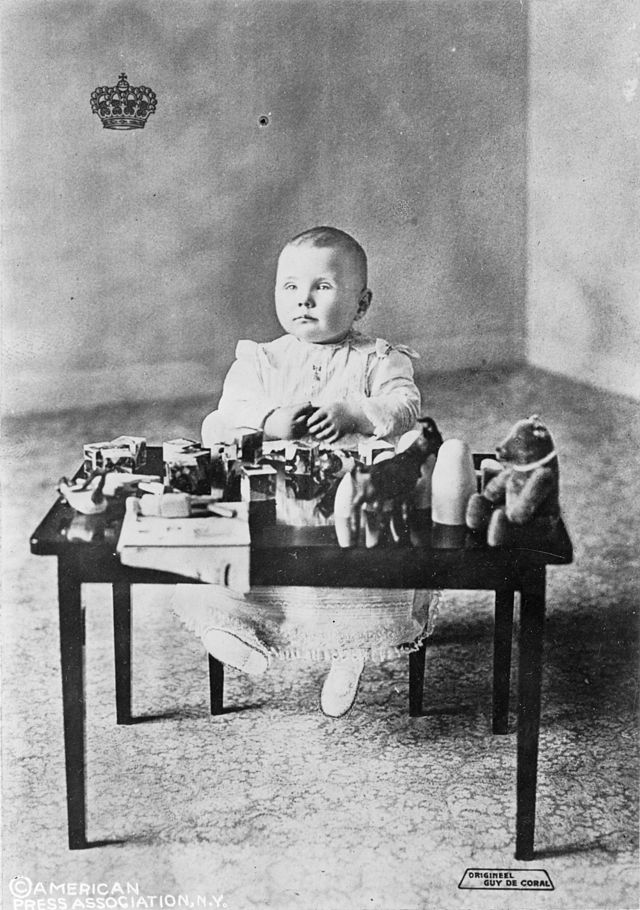by Susan Flantzer © Unofficial Royalty 2015

Prince Hendrik of the Netherlands; Credit: Wikipedia
Prince Hendrik was the husband of Queen Wilhelmina of the Netherlands and, thus far, is the longest-serving Dutch consort. Heinrich Wladimir Albrecht Ernst was born on April 19, 1876, in Schwerin in the Grand Duchy of Mecklenburg-Schwerin, now in the German state of Mecklenburg-Vorpommern. He was the youngest of the four children of Friedrich Franz II, Grand Duke of Mecklenburg-Schwerin, and his third wife, Marie of Schwarzburg-Rudolstadt.
Heinrich had three full siblings:
- Duchess Elisabeth Alexandrine (1869 – 1955), married Friedrich August II, Grand Duke of Oldenburg, had issue
- Duke Friedrich Wilhelm (1871 – 1897), unmarried
- Duke Adolf Friedrich (1873 – 1969), married (1) Princess Viktoria Feodora of Reuss-Schleiz, had issue; (2) Princess Elisabeth of Stolberg-Rossla, had issue
Heinrich had six half-siblings from his father’s first marriage to Princess Auguste of Reuss-Köstritz:
- Friedrich Franz III, Grand Duke of Mecklenburg-Schwerin (1851 – 1897), married Grand Duchess Anastasia Mikhailovna of Russia, had issue, including Alexandrine, Queen of Denmark and Cecilie, last Crown Princess of Prussia
- Duke Paul Friedrich (1852 – 1923), married Princess Marie of Windisch-Grätz, had issue
- Duchess Marie (1854 – 1920), married Grand Duke Vladimir Alexandrovich of Russia, had issue, including Grand Duke Kirill Vladimirovich a pretender to the Russian throne after the murder of his cousin Nicholas II of Russia.
- Duke Nikolaus (1855 – 1856) – died in infancy
- Duke Johann Albrecht (1857 – 1920), married (1) Princess Elisabeth Sybille of Saxe-Weimar-Eisenach, no issue; (2) Princess Elisabeth of Stolberg-Rossla, no issue
- Duke Alexander (born and died 1859), died in infancy
Heinrich had one half-sister from his father’s third marriage to Princess Anna of Hesse and by Rhine:
- Duchess Anne (1865 – 1882), unmarried, died in her teens
When Heinrich was seven years old, his father died. After finishing his secondary education in Dresden, he traveled to Greece and the British colonies of India and Ceylon. Heinrich then joined the Prussian Army and served as a first lieutenant in the Garde-Jäger-Bataillon in Potsdam, Prussia.
In 1900, Heinrich and Queen Wilhelmina of the Netherlands were introduced to each other by their mothers. After spending part of the summer together, they became engaged on October 16, 1900. The wedding preparations were overshadowed by the deaths of Wilhelmina’s uncle Karl Alexander, Grand Duke of Saxe-Weimar-Eisenach, on January 5, 1901, and Queen Victoria of the United Kingdom on January 22, 1901.
The couple was married on February 7, 1901, at the Grote of Sint-Jacobskerk in The Hague in the Netherlands. Following the wedding, Heinrich became a Prince of the Netherlands and took the Dutch version of his name, Hendrik. Wilhelmina decreed that the Dutch royal house would remain the House of Orange-Nassau and not change to the House of Mecklenburg-Schwerin. Although the marriage was peaceful, Hendrik and Wilhelmina grew apart due to her religious mysticism and his unfaithfulness and frustrations over his lack of an official role in the Netherlands.

Queen Wilhelmina & Prince Hendrik on their wedding day: Credit – Wikipedia
Wilhelmina had no surviving siblings at the time of her marriage, and the fear that the Dutch throne would pass to a German prince made it imperative that she provide herself with an heir. The couple’s only child, the future Queen Juliana, was born on April 30, 1909, to her parents’ great relief. Wilhelmina had several miscarriages before and after Juliana’s birth, as well as a stillborn child.

Juliana in 1910; Photo Credit – Wikipedia
Throughout his marriage, Hendrik was plagued by financial problems. He received no subsidy from the Dutch treasury, instead, he received an annual sum of 100,000 guilders from his wife. His activities and pastimes cost money, and he was expected to financially support charities and provide funds to his impoverished family in Germany. In addition, there was money Hendrik had to give to his mistresses who bore him illegitimate children. Dutch historian Gerald Aalders has said Prince Hendrik had eight known illegitimate children. After Hendrik’s death, Queen Wilhelmina continued to compensate the mothers of his illegitimate children.
Hendrik held various honorary appointments in the armed forces and served on the Council of State, but his wife kept him out of all political matters. He deeply regretted his rather insignificant position and said, “It’s not nice when you always want some more bacon and all that’s ever left is beans.”
Prince Hendrik had a great interest in the social and economic life in the Netherlands. He oversaw the merger of the two scouting organizations to create De Nederlandse Padvinders (The Netherlands Pathfinders), an organization that still receives royal patronage. He was chairman of the Dutch Red Cross and in 1928 he opened the Olympic Games in Amsterdam.

Funeral of Prince Hendrik; Credit – Wikipedia
During the last years of his life, Hendrik’s health quickly deteriorated. His arthritis worsened, he gained much weight, and he suffered his first heart attack in 1929. The second heart attack followed on June 28, 1934. During the afternoon of July 3, 1934, while in his office, Prince Hendrik died at the age of 58 of cardiac arrest. As per his wishes, he had a white funeral and was buried in the crypt at the Nieuwe Kerk in Delft.

The access to the royal crypt in the foreground; Credit – Wikipedia by Sander van der Wel from the Netherlands
This article is the intellectual property of Unofficial Royalty and is NOT TO BE COPIED, EDITED, OR POSTED IN ANY FORM ON ANOTHER WEBSITE under any circumstances. It is permissible to use a link that directs to Unofficial Royalty.
Kingdom of the Netherlands Resources at Unofficial Royalty






